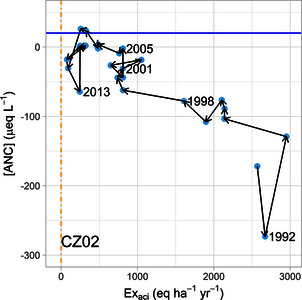Forsius, M., Posch, M.  ORCID: https://orcid.org/0000-0001-8649-9129, Holmberg, M., Vuorenmaa, J., Kleemola, S., Augustaitis, A., Beudert, B., Bochenek, W., et al.
(2021).
Assessing critical load exceedances and ecosystem impacts of anthropogenic nitrogen and sulphur deposition at unmanaged forested catchments in Europe.
Science of the Total Environment 753 e141791. 10.1016/j.scitotenv.2020.141791.
ORCID: https://orcid.org/0000-0001-8649-9129, Holmberg, M., Vuorenmaa, J., Kleemola, S., Augustaitis, A., Beudert, B., Bochenek, W., et al.
(2021).
Assessing critical load exceedances and ecosystem impacts of anthropogenic nitrogen and sulphur deposition at unmanaged forested catchments in Europe.
Science of the Total Environment 753 e141791. 10.1016/j.scitotenv.2020.141791.
Preview |
Text
1-s2.0-S0048969720353201-main (1).pdf - Published Version Available under License Creative Commons Attribution Non-commercial No Derivatives. Download (3MB) | Preview |
![[thumbnail of 1-s2.0-S0048969720353201-ga1_lrg.jpg]](https://pure.iiasa.ac.at/16645/7.hassmallThumbnailVersion/1-s2.0-S0048969720353201-ga1_lrg.jpg)  Preview |
Image
1-s2.0-S0048969720353201-ga1_lrg.jpg - Graphical Abstract Available under License Creative Commons Attribution Non-commercial No Derivatives. Download (129kB) | Preview |
Abstract
Anthropogenic emissions of nitrogen (N) and sulphur (S) compounds and their long-range transport have caused widespread negative impacts on different ecosystems. Critical loads (CLs) are deposition thresholds used to describe the sensitivity of ecosystems to atmospheric deposition. The CL methodology has been a key science-based tool for assessing the environmental consequences of air pollution. We computed CLs for eutrophication and acidification using a European long-term dataset of intensively studied forested ecosystem sites (n = 17) in northern and central Europe. The sites belong to the ICP IM and eLTER networks. The link between the site-specific calculations and time-series of CL exceedances and measured site data was evaluated using long-term measurements (1990–2017) for bulk deposition, throughfall and runoff water chemistry. Novel techniques for presenting exceedances of CLs and their temporal development were also developed. Concentrations and fluxes of sulphate, total inorganic nitrogen (TIN) and acidity in deposition substantially decreased at the sites. Decreases in S deposition resulted in statistically significant decreased concentrations and fluxes of sulphate in runoff and decreasing trends of TIN in runoff were more common than increasing trends. The temporal developments of the exceedance of the CLs indicated the more effective reductions of S deposition compared to N at the sites. There was a relation between calculated exceedance of the CLs and measured runoff water concentrations and fluxes, and most sites with higher CL exceedances showed larger decreases in both TIN and H+ concentrations and fluxes. Sites with higher cumulative exceedance of eutrophication CLs (averaged over 3 and 30 years) generally showed higher TIN concentrations in runoff. The results provided evidence on the link between CL exceedances and empirical impacts, increasing confidence in the methodology used for the European-scale CL calculations. The results also confirm that emission abatement actions are having their intended effects on CL exceedances and ecosystem impacts.
| Item Type: | Article |
|---|---|
| Uncontrolled Keywords: | Air pollution; Environmental effects; Modelling; Biogeochemistry; Trends |
| Research Programs: | Energy, Climate, and Environment (ECE) Energy, Climate, and Environment (ECE) > Pollution Management (PM) |
| Depositing User: | Luke Kirwan |
| Date Deposited: | 24 Aug 2020 04:55 |
| Last Modified: | 21 Feb 2022 08:32 |
| URI: | https://pure.iiasa.ac.at/16645 |
Actions (login required)
 |
View Item |
 Tools
Tools Tools
Tools